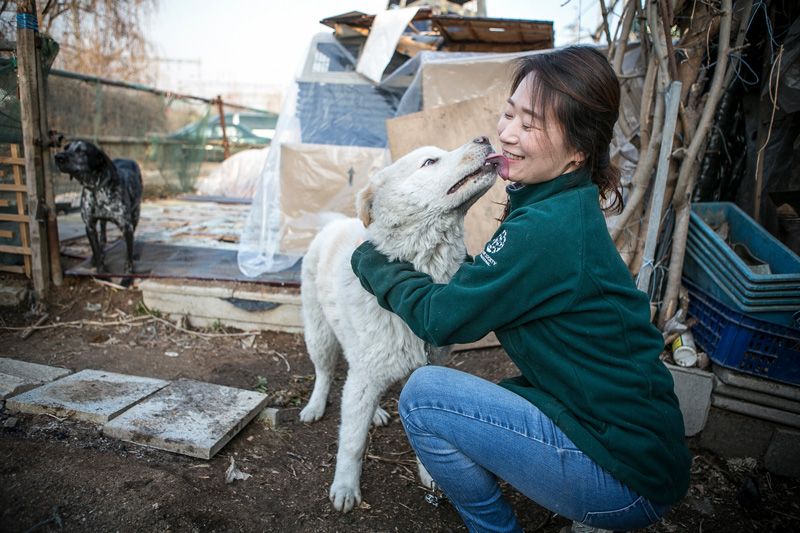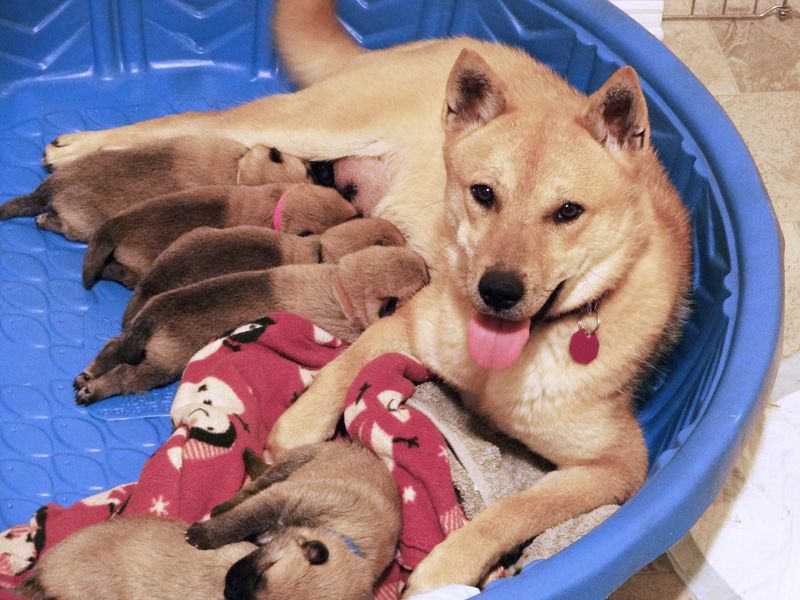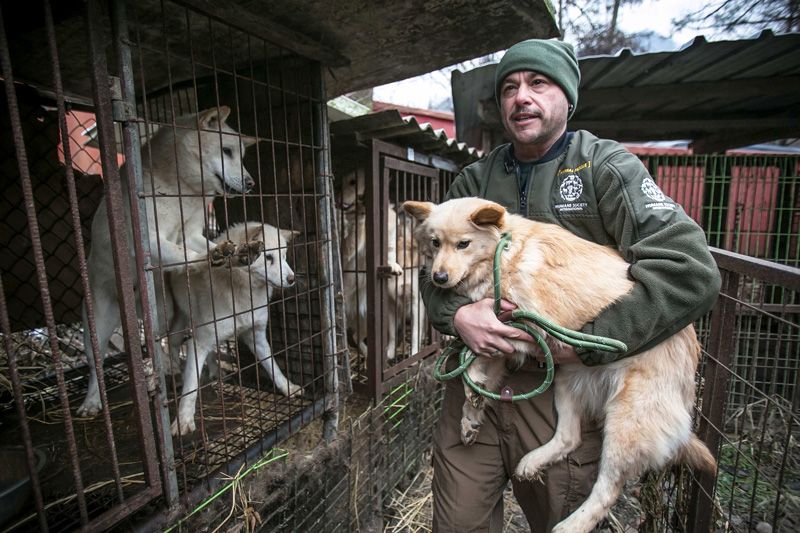Off the market
Changing the future for dogs in South Korea

It’s still dark, the coming dawn a wash of paler blue in the inky sky over Namyangju, a small city outside of Seoul, when the line of vans turns off the main highway onto a gravel side road. The vans ascend the narrow drive up a brushy, frozen hillside, assembling above a cluster of ramshackle metal and tarp hangars.
In the glow of the headlights, the team from Humane World for Animals and Humane Society International piles out to start their work—pulling on heavy-duty gloves and hats, their breath forming clouds in the freezing air. There’s a layer of frost over everything, patches of mottled, crunchy snow on the ground as they head into the warren of sheds. They can hear the barking, increasingly frantic, coming from the cages there.
The dogs heard the vans arrive, and as the team approaches in the gathering dawn, they’re up in their cages, some pacing and whirling, others cowering and shivering at the backs of their enclosures. A huge female dog with the coloring of a Saint Bernard paws at the front of her cage, eagerly waiting to be scratched around what remains of her ears—both her ears and her tail appear to have been chopped off. Cages full of fluffy white Jindos (a Korean breed that resembles a spitz) rattle as the dogs circle, excited and wary about the visitors.
Adam Parascandola crisscrosses between cages, checking on how the dogs have fared overnight. The director of animal protection and crisis response for HSI, Parascandola has worked in animal rescue for 20 years. Before moving to his current role, he worked for the HSUS and several local animal welfare groups, over the years pulling animals out of dozens of neglect situations, dogfighting operations and puppy mills. Since 2015, he’s made about 20 trips to South Korea, each time to help close down an operation like this one, one that may seem unreal to many Westerners: This is a dog farm, and the dogs here—until very recently—were to be slaughtered and sold for meat.
The compound is a maze, each hangar leading on to the next, each lined with cages full of dogs. Feces and trash—packets of instant coffee, rusted farm equipment, empty cigarette packs—are everywhere, ground into the icy tracks in the mud. Before the rescuers arrived, the dogs were eating the slop from a metal vat at the front of the compound. It’s full of what appears to be restaurant scraps: thin noodles, mussels, half a tangerine, hunks of unidentifiable bones too large to be poultry. The straw in the cages, the dogs’ only source of warmth, arrived a few days ago when the HSI team got to the site and began delivering relief to these animals.
Toward the back of the compound, a group of fluffy, wiggly golden retrievers wiggle harder as they spot the rescuers. One of them, a dog the team has named Mia, has wooed the rescuers with her tendency to lean in for pats and stand on her hind legs to wrap her “arms” around anyone game for a hug. These dogs don’t appear to have been here long— their fur is still fairly clean and they’re not fearful, happily greeting the rescuers who open their cages. It’s startling to see these dogs, who look like the pooches often pictured romping on the cover of L.L. Bean catalogs, in these rusted cages, bound for someone’s plate.

That fate once seemed inevitable. But it is changing today.
Over the next few weeks, all of these dogs—there are some 170 of them on this farm—will leave this place, never to return. They’ll get loaded onto planes, and after a long ride they will emerge on the other side of the world, stepping into the light and the care of shelter and fostering partners in the U.S., Canada and the U.K. From there, they’ll get the love and care they deserve.
Nara Kim of HSI, who used to work for an antipuppy mill organization in South Korea, says this kind of capacity was why she wanted to work for HSI. There are some good animal welfare organizations in the country, she says, “but none of them have the capacity to close down even one dog meat farm and help all these dogs.”
This is the 10th dog farm in South Korea that HSI has helped shutter, working with dog farmers who have decided to get out of what’s increasingly seen as a business without a future. The organization helps fund the farmers’ transition to a new career—be it vegetable farming or something else—and saves the dogs who are left on the farms. So far, more than 1,200 dogs have found freedom after these meat-farm closures.
Over time, HSI hopes to change the future for millions more.

Best friends on the table
The eating of dogs is not ubiquitous in Asia—Taiwan, Singapore, Hong Kong and the Philippines have all banned the slaughter of dogs for consumption—but in some countries, it remains dishearteningly common. People in Vietnam, Indonesia and China continue to consume dog meat. What South Korea has that some of those other countries don’t is an animal welfare law—one that provides animal welfare organizations grounds to go after the dog meat farmers on the basis of animal cruelty, says Kitty Block, HSI president and acting president and CEO of the Humane Society of the United States.
The animal welfare issues common to intensive confinement animal farming are present in dog farming—the animals are kept in crowded, filthy environments, and groups of dogs are often crammed into spaces far too small to hold them. Most caging offers little protection from the elements. Slaughter methods are brutal and repellent; the dogs are typically electrocuted, and some butchers deliberately inflict more intense suffering on the animals because of a common belief that the adrenaline rush caused by fear and pain makes the dog’s flesh taste better.
It’s a chilling reality, but there are reasons for hope: In South Korea, the attitude toward dogs and the dog meat trade has shifted hugely, even in the past few years. Pressure from international activists and from within Korean society has driven the change.
“I honestly haven’t seen another issue turn around this fast,” says Kelly O’Meara, senior director for companion animals and engagement for HSI.
The shift correlates with increasing advocacy around the issue, but also with modernization in South Korea and a growing culture of pet-keeping in the country. Even now, though, at a time when you can see women toting tiny dogs in designer purses and spot fancy dog grooming salons in Seoul, there remains a peculiar rift: A substantial number of Koreans believe that “pet” dogs and “meat” dogs are entirely different beings.
Lola Webber, now a consultant for HSI working on the dog meat issue, experienced this firsthand in 2012 while she was representing another nonprofit. She went to a market in Seoul where dogs were slaughtered for gaesoju (a “dog tonic” believed to have medicinal properties). At the time, small dogs were caged next to the cookers where dogs were boiled; bigger dogs were caged outside in the cold.
She saw two mastiff mixes, a breed commonly used in South Korea’s meat industry, and was heartbroken at the thought of the brutal deaths that awaited them. She wanted to take the dogs with her, but the trader recognized her as a Western activist and wouldn’t negotiate their release. So Webber reached out for help from sympathetic locals.
When she contacted the owner of a pet grooming business in Seoul, the woman was horrified at the idea of dogs found in the situation Webber described. But when Webber showed her a picture of the dogs, the whole interaction changed. “She literally said, ‘Oh thank goodness! You’ve misunderstood! These are ‘meat dogs!’” Webber remembers. “She seemed genuinely relieved and looked at me like I was crazy.”
In six years, though, there’s been a massive shift in attitudes. The markets rarely sell live dogs anymore, and there’s an increasing sense among the public that dog meat is a dirty, shameful business.
“When we first started, nobody wanted to talk about the dog meat trade. Nobody,” says Parascandola. “None of the media wanted to cover it; we couldn’t get anyone to come. The first press conference we had like two people. Now we have major coverage. All of the Korean networks have come, some of them have done extensive shows. Suddenly everyone’s talking about it.”
It’s a huge change, he says, “from this taboo subject that no one talks about to the point where the president of South Korea, when he was running [for election], felt the need to go to animal groups and tell them he supported banning dog meat. You would never have seen that in the past.” The president went on to adopt a “meat dog,” another first.
Now, at this closure, at least 10 reporters are on hand when the farmer himself shows up and takes their questions. Kim translates for the English-speaking media as the farmer acknowledges that dog farming is often a tradition, handed down from fathers to sons. “We don’t always have choices in our occupation,” he says.
Now, the government is exerting pressure, pushing for the end of the trade. “The dog meat industry is going down so badly,” he says. “It’s a dying business.”

A plan beyond rescues
In one of the vans, Block and O’Meara discuss their upcoming meetings with local politicians and other stakeholders, hashing out details of their plans for the future—conversations to be had, connections to be made, the critical networking that has the capacity to drive permanent change.
That’s what they’re after here. Helping farmers get out of the business and finding homes for their dogs doesn’t just save the lives of these animals. It’s a strategic move as well, gaining a press opportunity to maintain the message, spread awareness and make sure the issue stays on people’s minds, says O’Meara.
That’s critical to the long-term effort. While the lives of hundreds of dogs have been saved through these rescues, there are an estimated 2 million dogs in the meat industry in South Korea; dog meat is the fourth most commonly eaten meat in the country. In the coming years, HSI hopes to build support among Korean citizens and politicians for a change in the law, banning the dog meat trade completely.
It will take huge effort and funding to make it happen, and given the scale of the industry here, it would likely have to be a gradual phaseout. But considering where the issue stood just five years ago, the fact that such legislation even seems possible is astounding.
“We’d be nowhere near getting legislation in Vietnam, but South Korea is different,” Block says. Their next steps will be drafting legislation—modeled after Taiwan’s excellent, comprehensive ban— and trying to build support for it.

Dogs on the wing
In the cargo area of Incheon International Airport outside of Seoul, the team assembles the dogs’ crates for their long plane ride and then waits hours to ensure today’s group gets safely on board their flight. There are often hiccups onsite—slowdowns at the airport seem to happen too frequently—and Parascandola and Block have to start making phone calls to get the wheels turning.
At some point in their conversations with airline reps on the other end of the line, something seems to shift, and cargo personnel start running around quickly, heading out to the loading area where the dogs are all crated, checking the papers attached to their crates, summoning the forklift loaders.
After days of work in the cold and filth of the dog farm, the moment shines. The team breaks into spontaneous applause as the machines carry the dogs to the plane. Mia, who’s staying one more night in foster care before she, too, flies away to a new life, romps around on her leash, offering fluffy golden retriever-style hugs to one person after another.
As the dogs disappear into the hangar, a representative from the export company who’s been helping with HSI’s transports here confesses that while he’s happy to see the dogs go, the sight makes him feel embarrassed to be Korean. “I hate that people will see these dogs and know they had to be rescued from our country,” he says.
It’s easy to empathize. The dogs will have better lives in the places where they’re going, receive care from the shelters taking them in and eventually find loving homes and be cherished as companions.
But it’s worth stepping back and remembering: They’re headed to countries and societies where the majority of people still behave as though “pet” animals and “meat” animals are somehow different, the latter being soulless food sources whose suffering is no real source of concern.
Every culture has room to evolve. All animals deserve our kindness and protection. In Korea, in America, and around the world, animal protection groups are fighting for better lives for all of them.







